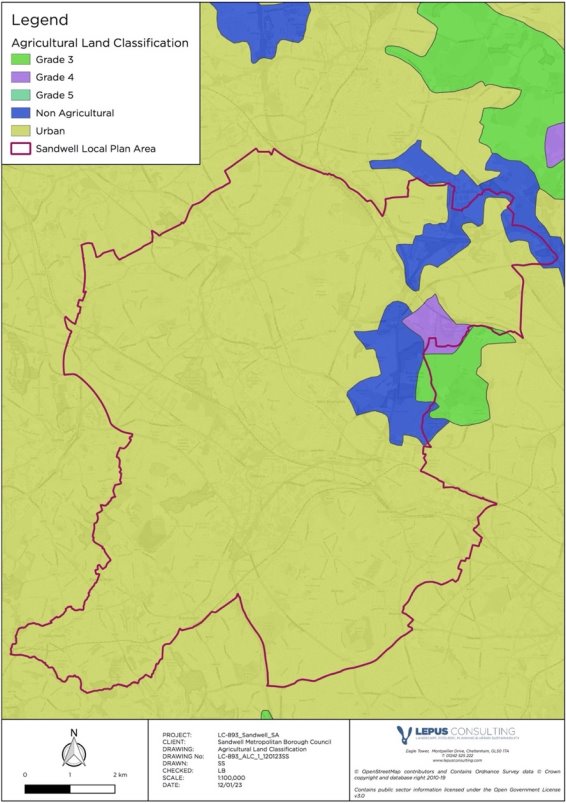Sustainability Appraisal of the Sandwell Local Plan 2024-2041
14 Soil
14.1 Introduction
14.1.1 National policies and strategies on soil, including DEFRA's 'Safeguarding our Soils' strategy[122], seek to prevent soil pollution; reduce soil erosion from wind and water; maintain soil diversity; improve the quality of soil, including through promoting an increase in organic matter in soil; and increase the resilience of soils to a changing climate. Focus should be placed on protecting the quality and availability of agricultural land, through reducing soil degradation and maintaining soil productivity.
14.2 Baseline and key issues
14.2.1 Soil is an essential and non-renewable resource that provides a wide range of ecosystem services. It filters air, stores and cycles water and nutrients, decomposes and cycles organic matter, supports plant growth and provides medicines. It is also one of the most important natural carbon sinks available and its conservation is therefore vital in efforts to mitigate climate change.
14.2.2 Development can potentially have adverse impacts on soil stocks, such as by direct loss of soil (e.g. excavating), contamination, increased erosion, breakdown of structure and loss of nutrients. The quality of soils in the UK has rapidly degraded, predominantly due to intensive agricultural production and industrial pollution.
14.2.3 As a highly urbanised borough, there are few areas of undeveloped land, the majority of which are restricted to the Green Belt. According to the Agricultural Land Classification (ALC), Sandwell is almost entirely 'urban' land, with sections of 'non-agricultural' land, a small area of Grade 4 ALC (poor quality agricultural land) and a small area of Grade 3 ALC (good to moderate quality agricultural land) found in the Sandwell Valley area in the north east of the borough (see Figure 10.1). The top three ALC grades, Grades 1, 2 and 3a, are referred to as 'best and most versatile' (BMV) land[123].
14.2.4 In accordance with the NPPF, development on previously developed land (PDL) is recognised as an efficient use of land. Development on previously undeveloped land will pose a threat to the soil resource within the proposal perimeter due to excavation, soil compaction, erosion and an increased risk of soil pollution and contamination during the construction phase. This is expected to be a permanent and irreversible impact.
14.2.5 It should be noted that PDL can also be of environmental value, and as such, potential impacts on natural resources should be considered on a site-by-site basis.
14.2.6 Many urban brownfield sites, and some greenfield sites, in Sandwell and the surrounding area are affected by the legacy of mining and industrial processes. It is anticipated that development proposals within the SLP will require site-specific assessments of ground contamination and effective remediation of soils affected prior to development.

Figure 14.1: Agricultural Land Classification in and around the SLP area (source: Natural England)
Key issues for resources include:
- Soil is a non-renewable resource that will continue to be lost as a result of new development proposed within the emerging SLP as well as supporting infrastructure. The majority of land in the SLP area is ALC 'urban', with pockets of ALC Grade 3 and 4, which may be under threat from new growth areas and associated infrastructure.
14.3 Impacts on soil
14.3.1 Box 14.1 sets out a plan-wide summary of the likely impacts on soil that have been identified through the SA process. These impacts are those identified prior to the consideration of mitigation in the form of Local Plan policies.
Box 14.1: Summary of identified impacts on soil
Impact on soil
Summary of identified impact

Direct loss of soil resources
Soil provides a range of essential services to the local area, including nutrient cycling, abating flood risk, filtering water, carbon storage and providing the basis for vegetation to flourish. In order for soil to continue providing each service, careful consideration should be given to its structure and stability. Where construction occurs, soil could potentially be compacted by heavy vehicles on-site. During the occupation or operation phase of development, soil, in some circumstances, could potentially be paved over, become subject to increased footfall or be subject to increased volumes of chemicals.
The SLP proposes development at 97 allocated sites. Of these 97 sites, 52 allocations are wholly or partially located on previously undeveloped land. Based on the indicative areas of these 52 sites, the SLP could result in the loss of up to approximately 224ha of previously undeveloped land or land with environmental value[124]. The development of new buildings on land with environmental value will be expected to result in a direct loss of soil resource, with little or no scope for mitigation.
14.4 Local Plan mitigation
14.4.1 The SLP seeks to promote an efficient use of resources and the spatial strategy directs new development within the existing urban areas and previously developed land where possible. Relevant SLP policies are discussed in Box 14.2.
Box 14.2: Mitigating effects of the Local Plan policies on soil
Policy mitigation for soil
Summary of mitigating effect

Policy mitigation for direct loss of the soil resources
The proposed development strategy for the SLP promotes the use of brownfield land as much as possible. Policy SDS1: Spatial Strategy for Sandwell states that development within the borough will seek to achieve sustainable development through "delivering development on brownfield sites in the urban area".
Underpinning Policy SDS1 are Policies SDS3: Regeneration in Sandwell which focuses on regeneration of existing urban areas, SCO3: Land contamination and instability which encourages development to make use of contaminated land, SDM3: Tall Buildings and Gateway Sites which supports higher density development and so will reduce overall land-take and make efficient use of land, and SHO2: Windfall developments which aims to prevent the use of unallocated greenfield land for development. These policies will help to ensure undeveloped land is protected and that previously developed land in urban areas is utilised.
Policies SNE1: Nature conservation, SNE2: Protection and enhancement of wildlife habitats, SNE3: Provision, retention and protection of trees, woodlands and hedgerows, SDS7: Sandwell's Green Belt and SDS8: Green and blue infrastructure in Sandwell, include measures that protect land and soil resources with ecological, agricultural or environmental value.
14.5 Residual effects on soil
14.5.1 As outlined in Box 14.2, the SLP includes measures to reduce the quantity of soil lost to development, including ensuring GI and open spaces are maximised and promoting the efficient use of land. However, some site allocations are situated on previously undeveloped land or land with environmental value. The policies within the SLP cannot fully mitigate the adverse impacts associated with loss of the soil resource and the associated ecosystem services it provides. Box 14.3 sets out the residual adverse effects of the SLP on soil.
Box 14.3: Residual effects for soil
Residual effects
Further details of the residual effect
Loss of soil resources
Despite seeking to make the best use of available brownfield sites, and ensuring the protection of high-quality agricultural land, the proposed allocations within the SLP will cumulatively result in the loss of a significant amount of previously undeveloped land or land which may have environmental / ecological value. Although the SLP aims to increase GI provision across the Plan area, the loss of permeable soils has potential to increase the risk of flooding and result in a loss of biodiversity across the Plan area. Loss of soil can also result in an increase in soil erosion and have subsequent impacts on air quality, agricultural yield and the ability of soil biome to effectively provide ecosystem services. Therefore, a residual adverse effect will be expected.
The loss of approximately 224ha of previously undeveloped land, is expected to be a long-term and permanent significant effect.
[122]DEFRA (2011) Safeguarding our soils: A strategy for England. Available at: https://www.gov.uk/government/publications/safeguarding-our-soils-a-strategy-for-england [Date accessed: 08/07/24]
[123]MAFF (1988) Agricultural Land Classification of England and Wales: Revised criteria for grading the quality of agricultural land. Available at: http://publications.naturalengland.org.uk/publication/6257050620264448?category=5954148537204736 [Date accessed: 08/07/24]
[124] Please note this figure is based on gross site areas and so does not take into account net developable areas excluding new open space / green infrastructure provision or sites which are already partially developed.
